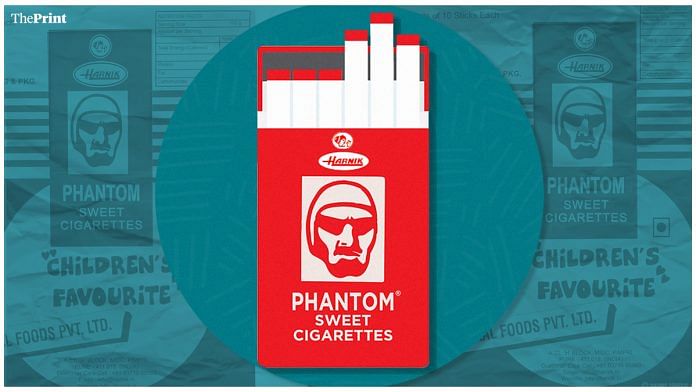
New Delhi: Sweet, sugary and rolled in controversy — the Phantom sweet cigarettes at one point defined childhood in the 1990s but has since been accused of promoting smoking among children.
Shaped like a cigarette, these sweet treats encased in a characteristic red-and-white box, were a staple for children and were also the definition of ‘cool’ as children posed with a Phantom cigarette.
“Phantom cigarettes candy is like a time machine for the kids who grew up in the 90s. Even by saying the name, it is like you are revisiting childhood. It reminds you of simpler and stress-free life,” Ritesh Sharma, 28, a sales executive, told ThePrint.
Why Phantom cigarettes were so popular
The USP of the candy was that it was designed to closely resemble actual cigarettes. Even the packaging was similar to a cigarette box. The masked mascot on the packaging resembled the titular character of the Phantom comics, which were created by American writer Lee Falk in 1936, and were extremely popular in the 1980s and 1990s.
“I would flaunt the cigarette candy in front of my friends or use it to pull a prank on my parents and teachers, which of course worked every time,” recalled Tarun, 28, who works at an advertising firm.
According to 30-year-old Raj Das, a lab technician, “The Phantom cigarette with its pseudo flame, made us all pseudo smokers at an early age. Holding it between my two fingers as a cigarette and pretending to be a grown-up … that was my flex back then.”
And it was these very attempts of boastful display that worried parents. Many feared the candy could desensitise children to the perils of smoking.
According to a study by Jonathan Klein of the University of Rochester in the US, the continued existence of candy cigarettes “helps promote smoking as a culturally or socially acceptable activity”.
Klein studied 25,887 American adults and noted that “22 per cent of current or former smokers had also regularly consumed candy cigarettes, while only 14 per cent of those who have never smoked had eaten or played with candy cigarettes often or very often”.
“Kids are naive and innocent … Just for the sake of making it look cool and funny by allowing them to stick those candies out of their mouth is something we should definitely not encourage,” 27-year-old Anita, a Teach For India Fellow, told ThePrint.
Unhealthy dose of sugar
Not only did these candies promote smoking, but they were also unhealthy.
In an interview to India Today, a spokesperson from Harnik General Foods Factory, which manufactured these candies, the Phantom cigarettes were not the “safest thing for those even on the brink of diabetes” since it was made of 75 to 80 per cent sugar while the remaining 20-odd per cent was glucose and gelatin. In other words, more sugar.
The Pune-based food company, also known as ‘Phantom factory’, was founded by food scientist N.L. Hingorani. Though the cigarette candy packets aren’t as easily available as they used to be, the brand is still available in the country and offers various other products such as instant dessert mix and chocolates like Doc Milk, Sweet Pan and Kaju Truffles among others.
Phantom cigarettes were a certified hit in India, but the concept of candy cigarettes is an old one.
They first appeared in the 1880s in the US as chocolate smokes, which were sold to both kids and adults. Since then, these candy cigarettes have been produced and reproduced in various forms across the world.
However, these sweets were later banned in 13 countries (including Canada, Brazil, Turkey and New Zealand) and some parts of the US.
Phantom cigarettes are now available online on Amazon, Flipkart and IndiaMART. A bulk order can be placed on the Harnik General Foods Factory’s official site as well.
Subscribe to our channels on YouTube & Telegram
Why news media is in crisis & How you can fix it
India needs free, fair, non-hyphenated and questioning journalism even more as it faces multiple crises.
But the news media is in a crisis of its own. There have been brutal layoffs and pay-cuts. The best of journalism is shrinking, yielding to crude prime-time spectacle.
ThePrint has the finest young reporters, columnists and editors working for it. Sustaining journalism of this quality needs smart and thinking people like you to pay for it. Whether you live in India or overseas, you can do it here.